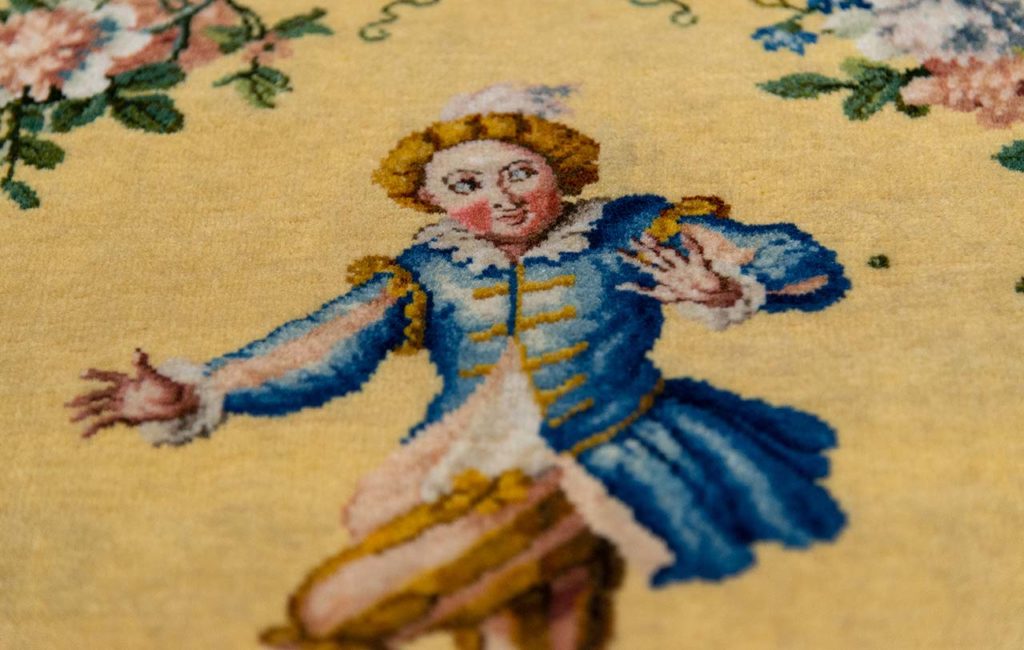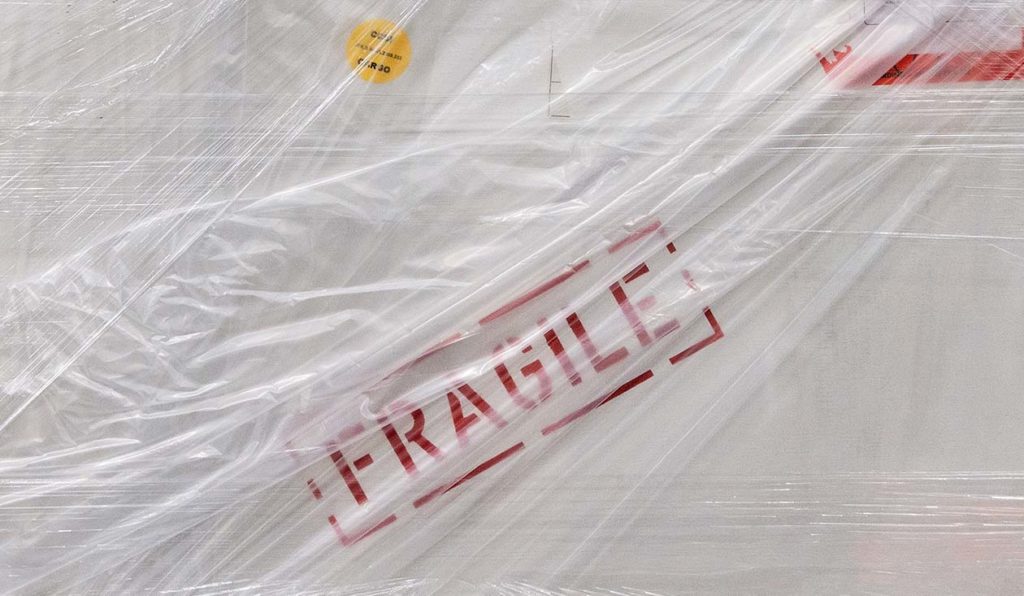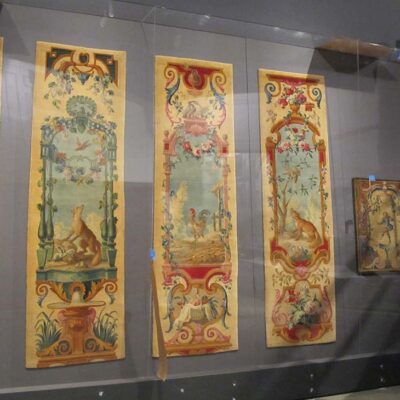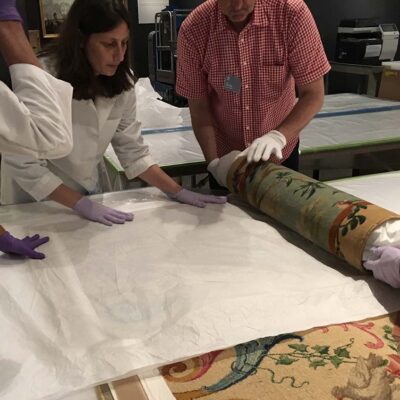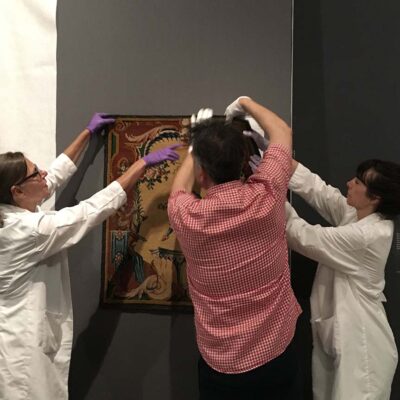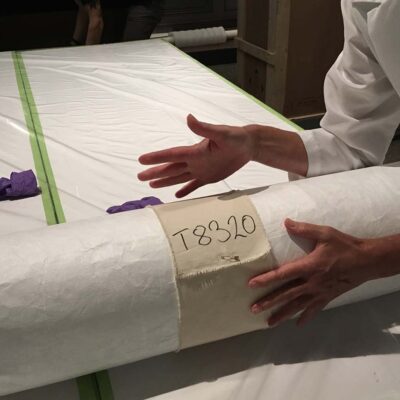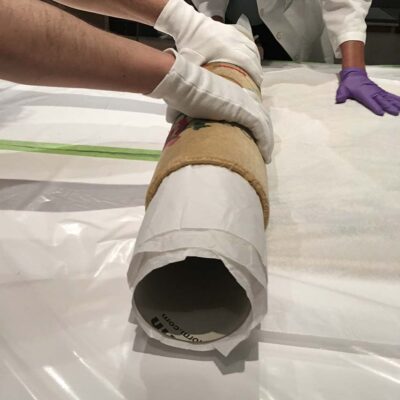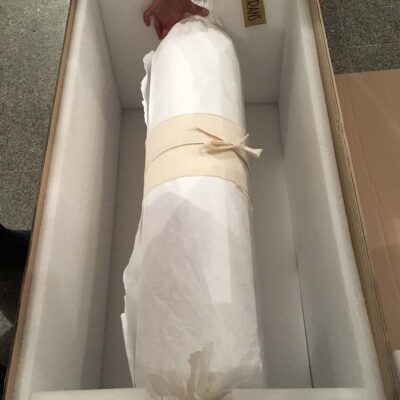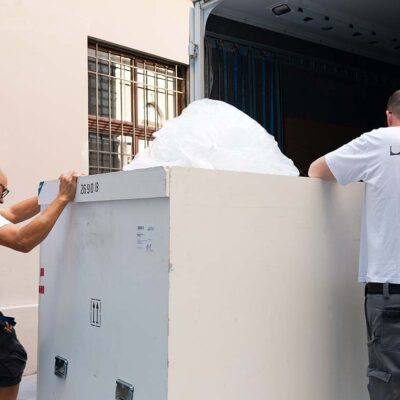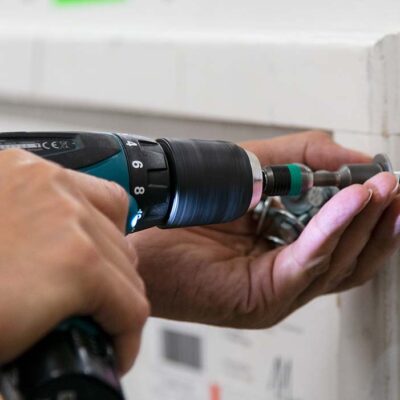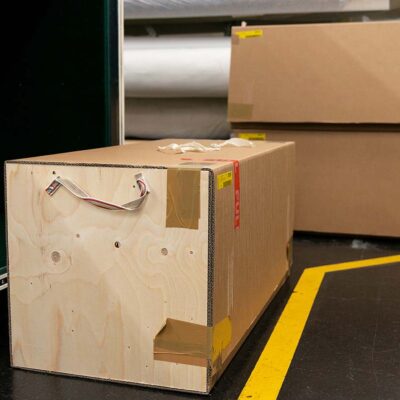27. August 2018
MAK-Sammlungsobjekte gehen auf Reise. Vom MAK-Depot über Versailles nach New York und retour nach Wien
Für die gemeinsam vom Schloss Versailles und dem Metropolitan Museum of Art organisierte Ausstellung Visitors to Versailles (1682–1789) gingen im Herbst 2017 fünf textile Sammlungsobjekte – ein Savonnerie-Kaminschirm und vier Savonnerie-Paraventpaneele − aus der MAK-Sammlung Textilien und Teppiche auf Reisen. Die Objekte aus der 2. Hälfte des 18. Jahrhunderts wurden für die Ausstellung, die vom 24. Oktober 2017 bis 25. Februar 2018 in Versailles und im Anschluss daran vom 16. April bis 29. Juli 2018 in New York zu sehen war, als Leihgaben angefragt. Susanne Schneeweiss, Registrarin des MAK, bietet anhand dieses Beispiels einen Blick hinter die Kulissen des Leihverkehrs.
Der Austausch von Kunstobjekten zwischen nationalen und internationalen Kunstinstitutionen zählt zu einer wichtigen Aufgabe in der Museumsarbeit. Viele der Sammlungsobjekte können transportiert werden, sind also mobil und können an andere Museen verliehen werden. Das MAK verfügt über eine einzigartige Sammlung zu angewandter Kunst, Design, Architektur und Gegenwartskunst, die bei LeihnehmerInnen sehr begehrt ist. Für den Erhaltungszustand der Kunstobjekte stellen der Transport und der Ortswechsel allerdings aus restauratorischer Sicht ein Risiko dar, das vom Museum im Vorfeld abgeschätzt werden muss. Entsprechend werden Vorkehrungen für den Transport und die Präsentation am Ausstellungsort getroffen beziehungsweise vom Museum auch vorgegeben.
Wie kommt es zu einer Leihgabe?
„Im Rahmen der Recherche zu einer Ausstellung bedienen sich die LeihnehmerInnen oft auch der digitalen Sammlungsdatenbank, die online abrufbar ist, und werden dabei auf die jeweiligen Sammlungsobjekte eines Museums aufmerksam oder setzen sich direkt mit den jeweiligen SammlungsleiterInnen in Verbindung. Der Leihantrag wird immer direkt an die Leitung des Museums gerichtet. Danach erhält die Registrarin den Antrag und setzt sich mit den SammlungsleiterInnen und der Restaurierung in Verbindung, um die Objekte vor dem Leihverkehr prüfen zu lassen“, schildert Susanne Schneeweiss die ersten Schritte des Leihverkehrs.
Freigabe der Objekte für die Reise
Bei den für die Ausstellung Visitors to Versailles angefragten textilen, französischen Savonnerien handelt es sich um in Frankreich gefertigte Knüpfteppiche des 17./18. Jahrhunderts, von denen das MAK eine bedeutende Sammlung besitzt. „Die Manufacture royale in Chaillot wurde 1626 gegründet und war führend auf dem Gebiet der Teppichproduktion in Europa. Sie produzierte ähnliche Teppiche wie im Orient, allerdings entwickelte sich rasch eine eigene Formensprache, die dem französischen Hofgeschmack und der Mode entsprach. Die luxuriösen Savonnerien kamen nie auf den Markt, sie waren ein diplomatisches Geschenk aus Frankreich an Kaiser Joseph II.“, erklärt Silke Geppert, Kustodin der MAK-Sammlung Textilien und Teppiche.
- Savonnerien © The Metropolitan Museum of Art, photo by Olha Yarema-Wynar
- Savonnerien v.l.n.r: Giulia Chiostrini, Branislav Djordjevic © The Metropolitan Museum of Art, photo by Olha Yarema-Wynar
- Savonnerien v.l.n.r.: Kathrin Colburn, Branislav Djordjevic, Alexandra Barlow © The Metropolitan Museum of Art, photo by Olha Yarema-Wynar
„Ein wichtiger Schritt im Rahmen eines Leihverkehrs ist auch die Klärung der Form der Präsentation – in Vitrinen, an der Wand oder auf Podesten – in enger Zusammenarbeit mit der Restaurierung. Vor allem bei Textilien muss vorab sehr genau überlegt werden, welche Montagevorrichtungen verwendet werden können und ob die Objekte hängend oder liegend ausgestellt werden sollen. Visitors to Versailles zeigte die Teppiche sowohl im Schloss Versailles als auch im Metropolitan Museum of Art leicht schräg hängend in Vitrinen. Auch die Lichtbedingungen und die Luftfeuchtigkeit werden seitens der RestauratorInnen vorgegeben und sind am Ausstellungsort unbedingt einzuhalten“, so Schneeweiss.
- Savonnerien © The Metropolitan Museum of Art, photo by Olha Yarema-Wynar
- Savonnerien © The Metropolitan Museum of Art, photo by Olha Yarema-Wynar
- Savonnerien © The Metropolitan Museum of Art, photo by Olha Yarema-Wynar
Bevor Sammlungsobjekte in Begleitung eines Kuriers das Haus verlassen dürfen, werden auch der Transport, die Spedition, die Verpackung der Kunstwerke und der Versicherungswert festgelegt. Im Falle einer internationalen Leihgabe muss die Ausfuhr der Sammlungsobjekte außerdem vom Bundesdenkmalamt genehmigt werden. Die Restaurierung erstellt vor dem Verpacken gemeinsam mit der Sammlungsleitung ein Zustandsprotokoll, in dem der momentane Zustand der Objekte festgehalten wird. „Die vier Savonnerie-Paraventpaneele wurden gerollt in Kisten gegeben, der Kaminschirm flachliegend in einer Kiste verpackt“, schildert Martina Dax, Mitarbeiterin der MAK-Sammlung Textilien und Teppiche, die als Kurier die Objekte nach Versailles begleitete.
Die Sammlungsobjekte verlassen das MAK-Depot
„Generell werden die Objekte sehr knapp vor Ausstellungsbeginn angeliefert, um sie unter anderem vor zu starkem Lichteinfluss während des Aufbaus der Ausstellung zu schützen. Bevor sie aus den Kisten genommen werden, müssen sie circa 24 Stunden vor Ort klimatisiert werden, um Schäden, die durch zu große Temperatur- und Feuchtigkeitsunterschiede entstehen könnten, zu vermeiden. Die Klimatisierung wird ebenfalls vom Kurier kontrolliert. Anschließend werden die Objekte aus den Kisten genommen und vom Kurier auf Schäden überprüft. Die Übernahme der Objekte wird dann mittels Zustandsprotokoll im Beisein der LeihnehmerInnen und des MAK-Kuriers bestätigt“, schildert Schneeweiss.
Die Sammlungsobjekte reisen zurück nach Wien
Die Rückreise der Savonnerien aus New York wurde wie üblich rund einen Monat vor Ausstellungsende geplant und von MAK-Sammlungsmitarbeiter Branislav Djordjevic begleitet. Schneeweiss: „Zu den Aufgaben von Branislav Djordjevic zählte es, die Objekte direkt von den Vitrinen, in denen sie ausgestellt waren, im Beisein der LeihnehmerInnen entgegenzunehmen und auf Schäden zu prüfen. Anschließend wurde das Zustandsprotokoll von beiden Seiten unterzeichnet, bevor die Objekte verpackt und zum Transport nach Wien freigegeben wurden.“
- Transport Savonnerien © MAK/Mona Heiß
- Transport Savonnerien © MAK/Mona Heiß
- Transport Savonnerien © MAK/Mona Heiß
Im August wurden die Savonnerien mit dem Kunsttransport ins MAK gebracht, wo sie durch die MAK-Restaurierung kontrolliert und noch einmal das Zustandsprotokoll geprüft wurde. Erfreulicherweise sind die Objekte ohne Schäden heimgekehrt und können wieder geschützt im MAK-Depot ruhen, bis sie ein weiteres Mal der Öffentlichkeit präsentiert werden.
Ein Beitrag von Sandra Hell-Ghignone, MAK-Presse und Öffentlichkeitsarbeit
————————–
English Version:
MAK COLLECTION OBJECTS ON TOUR: FROM THE MAK DEPOT VIA VERSAILLES TO NEW YORK AND BACK AGAIN.
In autumn 2017 five textile collection objects―one Savonnerie fire screen and four Savonnerie screen panels―from the MAK Textiles and Carpets Collection went on tour as part of an exhibition entitled Visitors to Versailles (1682–1789), organized in cooperation with the Palace of Versailles and the Metropolitan Museum of Art. The objects from the second half of the 18th century were requested as loans for the exhibition which ran from 24 October 2017―25 February 2018 in Versailles and subsequently from 16 April 2018―29 July 2018 in New York. Using this loan as an example, Susanne Schneeweiss, registrar of the MAK―Austrian Museum of Applied Arts / Contemporary Art, offers a look behind the scenes of the inter-museum loaning system.
The national and international exchange of works of art between art institutions is one of the most important tasks of museums. Many objects from a museum’s collection are transportable and are therefore mobile and can be loaned to other museums. The MAK has a unique collection of applied art, design, architecture, and contemporary art objects which is in great demand among borrowers. However, seen from the perspective of conservation, the transport and change of location present risks to the conservation status of the works of art which need to be evaluated before the objects are transported. In accordance with this evaluation precautionary measures for the transport and the presentation at the exhibition venue have to be assessed and prescribed by the museum which is loaning the object.
How are loans arranged?
Susanne Schneeweiss describes the first steps of the loan process as follows: “In the course of research for an exhibition borrowers also use digital databases which are available online, and in doing so they become aware of respective objects in the collections belonging to other museums. The would-be borrowers then make direct contact with the heads of the respective collections. The loan proposal is always made directly to the director of the museum. Subsequently, the registrar of the museum receives the proposal and then contacts the heads of both the respective collection and of the conservation department in order to evaluate the objects before transport.”
Clearing objects for their journey
The textiles which were requested for the exhibition Visitors to Versailles were French Savonnerie works, knotted-pile carpets, produced in the 17/18th century. The MAK owns an important collection of such works. “The Manufacture Royale in Chaillot was established in 1626 and was the leading manufacturer of carpets in Europe. It produced carpets similar to those produced in the Orient, however it quickly developed its own designs which conformed to the taste and styles of the French court. The luxurious Savonnerie works never appeared on the market, they were diplomatic presents from France for Emperor Joseph II.,” explains Silke Geppert, curator of the MAK Textiles and Carpets Collection.
- Savonnerien © The Metropolitan Museum of Art, photo by Olha Yarema-Wynar
- Savonnerien v.l.n.r.: Kathrin Colburn, Branislav Djordjevic, Alexandra Barlow © The Metropolitan Museum of Art, photo by Olha Yarema-Wynar
- Savonnerien v.l.n.r: Giulia Chiostrini, Branislav Djordjevic © The Metropolitan Museum of Art, photo by Olha Yarema-Wynar
“An important step in the loan process is the choice of how to present the object―in a display case, on the wall or on a pedestal―together with the staff of the conservation department. Particularly in the case of textiles one has to carefully consider which mounting fixtures can be used and whether the objects should be exhibited in a hanging or lying position. Visitors to Versailles displays the carpets in both the Palace of Versailles as well as the Metropolitan Museum of Art in a slightly slanted, hanging position in display cases. The lighting conditions and the humidity of the display room are specified by the conservation experts and must be adhered to at the exhibition venue,” Schneeweiss states.
- Savonnerien © The Metropolitan Museum of Art, photo by Olha Yarema-Wynar
- Savonnerien © The Metropolitan Museum of Art, photo by Olha Yarema-Wynar
- Savonnerien © The Metropolitan Museum of Art, photo by Olha Yarema-Wynar
Before objects from the collections are allowed to leave the museum, accompanied by a museum courier, the conditions for the transport, handling, and packing of the objects and the insurance have to be determined. In the case of an international loan the export of the objects must also be authorized by the Federal Monuments Office. Before the objects are packed the conservation department and the head of the collection evaluate the condition of the objects and write a condition report which records the current state of the objects. Martina Dax, staff member of the MAK Textiles and Carpets Collection who accompanied the objects to Versailles, describes the packing as follows: “The four Savonnerie screen panels were rolled and placed in crates, while the fire screen was packed in a crate in a flat lying position.”
The collection objects leave the MAK Depot
“In general the objects are delivered very shortly before an exhibition begins in order to protect them from being exposed to too much light during the construction of the exhibition. Before they are removed from their crates they have to acclimatize to their surroundings for at least 24 hours in order to avoid damage which can be caused by too drastic changes in temperature or humidity. The climate controls are also tested by the courier. The objects are then removed from the crates and inspected for damage by the courier. The takeover of the objects is verified by countersigning the condition report in the presence of both the courier from the MAK and the borrower,” Schneeweiss explains.
The collection objects travel back to Vienna
The return transport of the Savonnerie objects from New York to Vienna was, as usual, planned about one month before the planned end of the exhibition and in this case Branislav Djordjevic, MAK Collection staff member, accompanied the objects as courier. Schneeweiss states: “One of Branislav Djordjevic’s tasks is to supervise the de-installation of the objects directly from the display cases in which they were displayed and, in the presence of the borrower, to inspect the objects for damage. A condition report is then signed by both parties before the objects are packed and released for the transport back to Vienna.”
- Transport Savonnerien © MAK/Mona Heiß
- Transport Savonnerien © MAK/Mona Heiß
- Transport Savonnerien © MAK/Mona Heiß
In August the Savonnerie objects were delivered back to the MAK by the fine arts transport service. They were then inspected by the MAK Conservation department and the condition report was checked once again. The objects returned home in good condition and could be placed again in the MAK Depot where they can rest protected until they are ready to be presented to the public again.
A contribution from Sandra Hell-Ghignone, MAK Press and Public Relations
